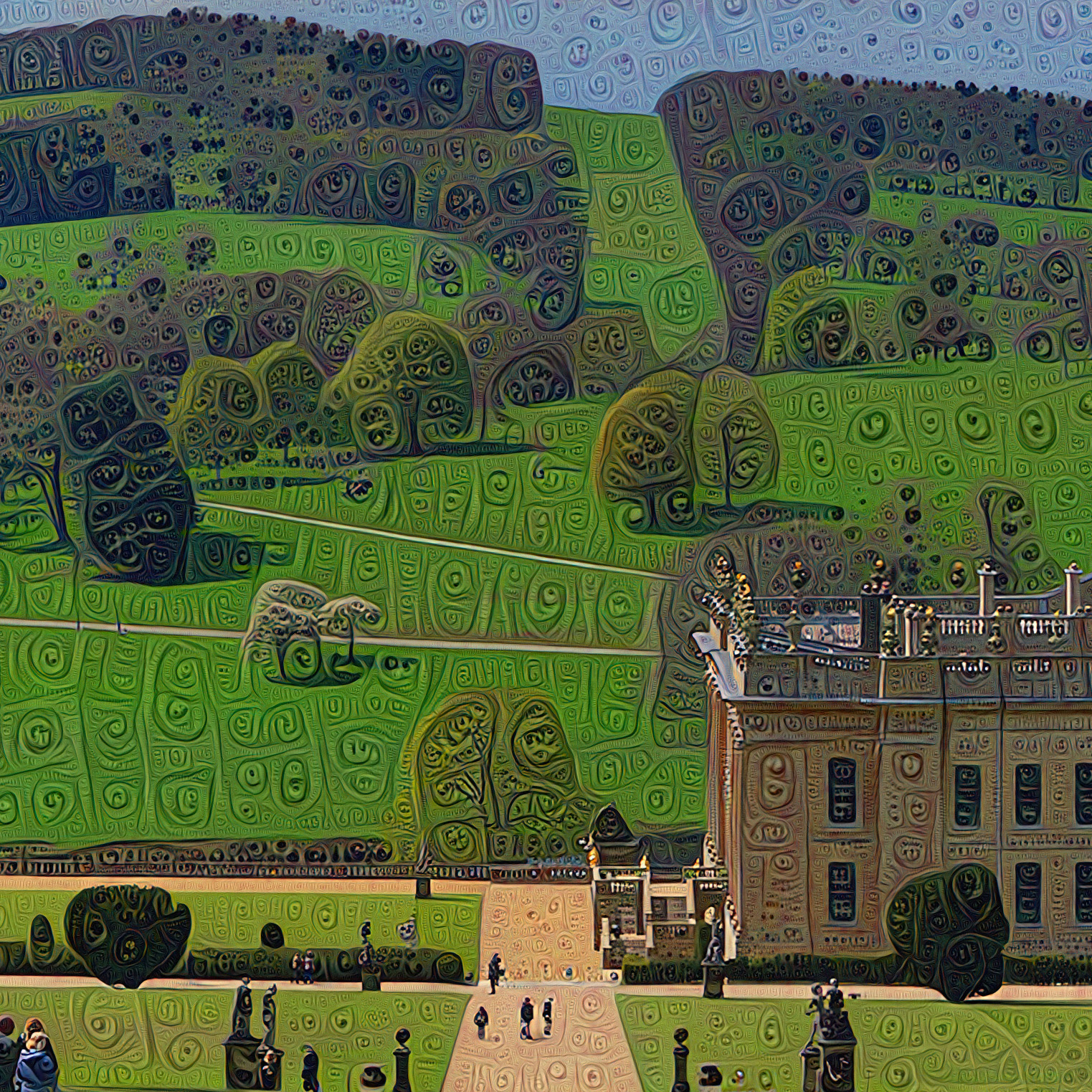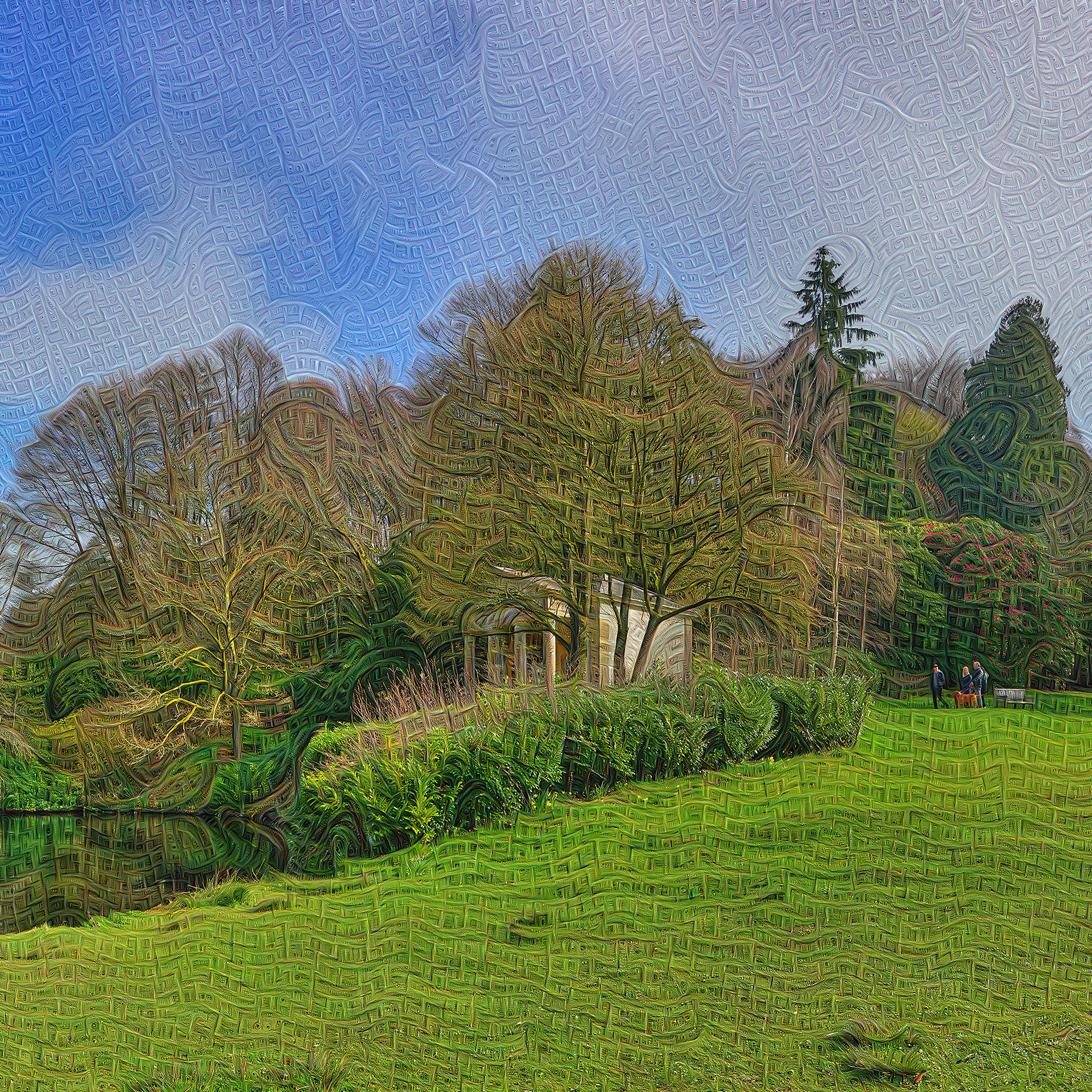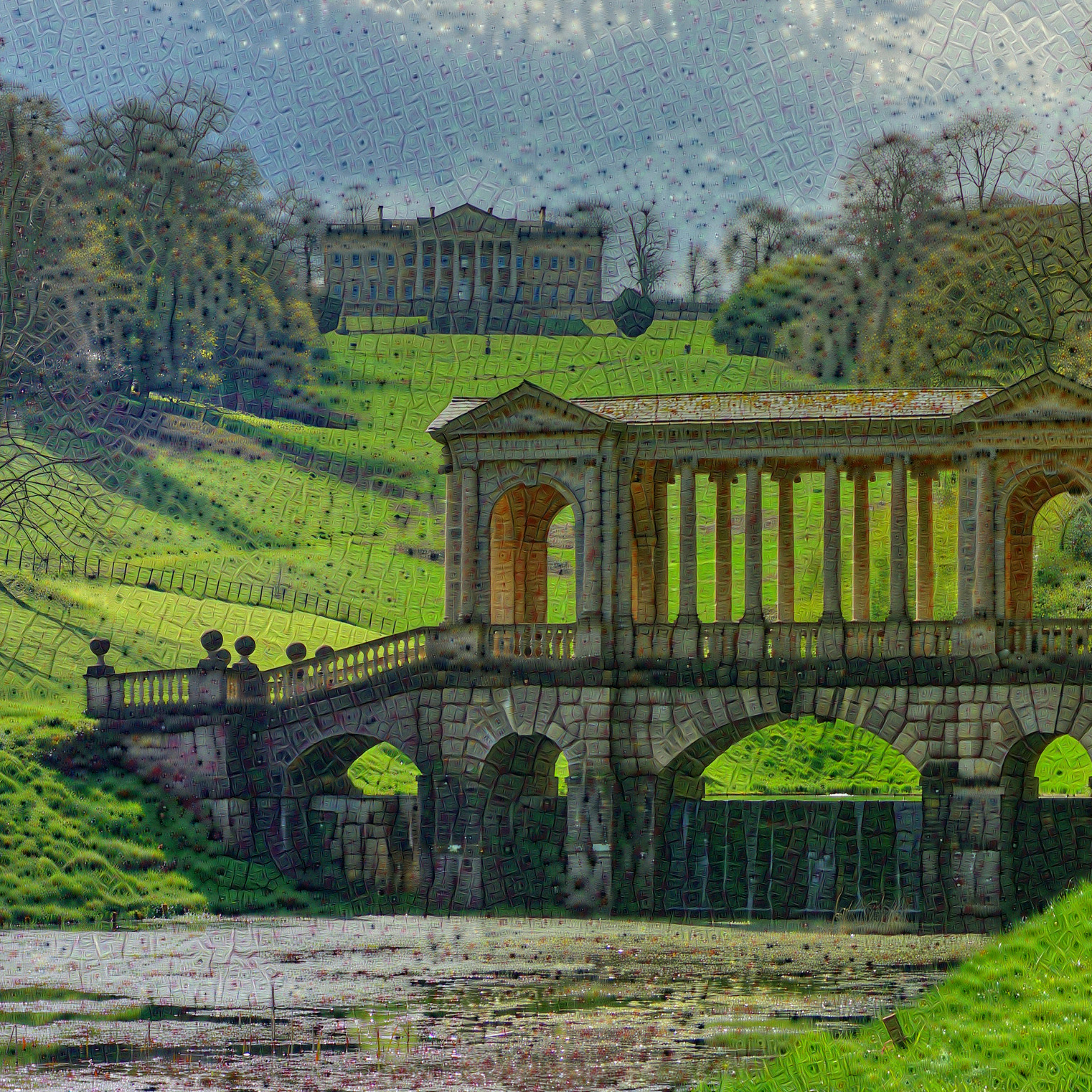Capability Brown meets AI: the perverted nature of Daniel
Ambrosi
An exhibition at London’s Robilant + Voena gallery presents
the landscapes of Capability Brown as never experienced before. Artist Daniel
Ambrosi has digitally manipulated picturesque views before using AI software to
create hallucinogenic reimaginings. For recessed.space, Steve Taylor took a
walk through the landscapes of uncanny valley.
Daniel Ambrosi’s landscape images
have a complex – one might say convoluted – relationship with a head-spinning
range of artistic techniques and media technologies; painting, landscape
design, photography, artificial intelligence, and digital printing, to name
just a few. Their lineage stretches all the way from Claude Lorrain to Beeple,
without exactly belonging to either’s creative discipline, or to that of any
artist working in the interim. Despite meeting the eye with a near-hyperreal
vividness, they exist in a weird space on the cusp between (or perhaps more
accurately the edge of) accepted genres or types of image.
The works consist of views of enduring historical landscape designs – Blenheim, Stowe, Chatsworth, Compton Verney, and others – mostly, but not exclusively, created by Lancelot ‘Capability’ Brown, the eighteenth-century master of manmade nature, a mode of artifice that ended up defining a default notion of the English landscape.
![]()
![]()
Brown’s sculpted parks, elaborate water features and gentle gradients were never the whole story, though. Each cushioned a grand house designed by one of his architect contemporaries, while he occasionally got to build a few minor structures within his overall remit: a Gothic bathhouse, menagerie, or spindly monument to a cider magnate. Without their country piles, representations of Brown’s work are liable to look flat and, to the inexpert gaze, somewhat featureless, so it’s no surprise that most of Ambrosi’s images incorporate these monumental buildings – many of them also repositories of historic artworks – as their nominal focal point, or in the near-foreground where they replicate the longer view of the parkland enjoyed by their wealthy, privileged owners. Sunil Manghani reminds us, in the catalogue for the show, of John Berger’s assertion that “the ‘philosophic enjoyment of unperverted Nature’ is typically preconditioned by the possession of private land.”
But what is it that Ambrosi has done to these oh-so-familiar views? Quite a lot, it turns out, despite that familiarity – though even that is not what it seems. The artist works from photographs, which partly explains an apparent verisimilitude. But he does not employ any old reference shots, instead Ambrosi has developed what he refers to as a unique version of computational photography in which he uses several computer programmes to stitch together multiple images, creating extremely high resolution and immersive panoramic landscapes. These are then processed through Google’s DeepDream AI software, tweaked to Ambrosi’s specific parameters, which allows the artist a degree of license to direct the results.
![]()
![]()
![]()
DeepDream, as Ambrosi was keen to point out at a recent artist’s talk at the gallery, is hardly state-of-the-art, being already dated in the context of AI’s alarmingly fast evolution. In deference, perhaps, to Robilant + Voena’s clientele, more habituated to purchasing old masters, the artist emphasised the extent of his own agency in the production process (generally, as is often the case with new creative technologies, process was much more prevalent as a topic of conversation than aesthetics) and the relatively tight boundaries within which DeepDream is permitted to do its thing. By contrast, the Dover Street audience may have found the disturbing, briefly notorious, phantasmagorical visions it ‘dreamt’ when initially given rein in 2015 a little hard to stomach.
No such delicacy held back one of Ambrosi’s fellow panellists, author and emeritus professor Arthur I Miller, who threw a handful of posthuman bombshells into the proceedings by declaring that “there will come a time when humans are not in the loop” of artistic endeavour. However, by then “we’ll have merged with machines” - so no problem. The third panellist, Capability Brown specialist Steffie Shields, struck a more sympathetic note that roused a couple of her fellow experts to not only speak authoritatively, but in one instance get to their feet and deliver a short impromptu lecture. The result was an oddly polarised conversation; brain-melting AI accelerationism on the one hand, a detailed passion for historic landscape design on the other, and the works of art on display and under discussion floating somewhere in the middle.
![]()
![]()
![]()
From a distance, these works, with their luminosity and saturated colours, make a strong impact. Computational photography gives them an uncanny width and depth that no conventional media format can match. They seem to shimmer and vibrate visually, an effect of fractal detailing within the patterns generated when DeepDream latches onto a visual trope – a knot in a tree trunk, for example – and repeats it over every surface in the image, from sky to lake.
They’re not quite right, or so your visual acculturation tells you; consuming them as a form of art, it’s hard to shake this sense of something being off. It would be too simplistic to attribute that feeling to the involvement of AI, given the role DeepDream plays in their production, adding a layer of barely-random neural network jiggery-pokery to complex visual assemblages that have already been subject to extensive processing by technology.
With the precipitous recent collapse of the NFT bubble, an opportunity to distance one’s work from the froth of digital art could well work in Ambrosi’s favour, and as indicated by the striking rift in how the audience for his artist’s talk regarded these pieces, there’s always a possibility that opinions will swing back towards the pole where the pieces are simply read as amped-up landscape images, with AI taking a back seat.
![]()
![]()
![]()
There’s no doubt as to Ambrosi’s sincerity – the work proceeds from his “rapturous experience” of landscapes that capture his imagination – nor his commitment to innovation or collaboration with colleagues at the top of their game. But the work itself? Doubts linger.
One is drawn back to Berger and the aristocratic remodelling of land into landscape, a legacy that is hard to ignore in a country where rights and access to the countryside continue to be denied to the commoner and gifted to the landowner, whose viewpoint Ambrosi’s pictures often adopt. These elegant, extensive estates with their grand houses were never just visual treats, panoramas of ocular pleasure; but because Ambrosi’s process only mutates their appearance, within familiar-enough framings and perspectives, it does little to transform the meaning of such representations. To use a trope more usually applied to hypermodern urban scenes; there’s no there, there.
Nevertheless, as Ambrosi points out, their visual particularities do induce a distinct affect, though whether this is merely the landscape equivalent of tech’s uncanny valley or something deeper is moot. One way of describing it might be, pace Berger, as the “philosophic enjoyment of perverted Nature”, transformed once by its seventeenth century remodelling and again by its twenty-first century manipulation in the form of a digital image. Perhaps what we are still being wowed by – only rendered this time in a new material iteration – is nothing more than the contrived beauty of landscapes created through the application of huge sums of money.
The works consist of views of enduring historical landscape designs – Blenheim, Stowe, Chatsworth, Compton Verney, and others – mostly, but not exclusively, created by Lancelot ‘Capability’ Brown, the eighteenth-century master of manmade nature, a mode of artifice that ended up defining a default notion of the English landscape.


Figs.i,ii
Brown’s sculpted parks, elaborate water features and gentle gradients were never the whole story, though. Each cushioned a grand house designed by one of his architect contemporaries, while he occasionally got to build a few minor structures within his overall remit: a Gothic bathhouse, menagerie, or spindly monument to a cider magnate. Without their country piles, representations of Brown’s work are liable to look flat and, to the inexpert gaze, somewhat featureless, so it’s no surprise that most of Ambrosi’s images incorporate these monumental buildings – many of them also repositories of historic artworks – as their nominal focal point, or in the near-foreground where they replicate the longer view of the parkland enjoyed by their wealthy, privileged owners. Sunil Manghani reminds us, in the catalogue for the show, of John Berger’s assertion that “the ‘philosophic enjoyment of unperverted Nature’ is typically preconditioned by the possession of private land.”
But what is it that Ambrosi has done to these oh-so-familiar views? Quite a lot, it turns out, despite that familiarity – though even that is not what it seems. The artist works from photographs, which partly explains an apparent verisimilitude. But he does not employ any old reference shots, instead Ambrosi has developed what he refers to as a unique version of computational photography in which he uses several computer programmes to stitch together multiple images, creating extremely high resolution and immersive panoramic landscapes. These are then processed through Google’s DeepDream AI software, tweaked to Ambrosi’s specific parameters, which allows the artist a degree of license to direct the results.



Figs.iii-v
DeepDream, as Ambrosi was keen to point out at a recent artist’s talk at the gallery, is hardly state-of-the-art, being already dated in the context of AI’s alarmingly fast evolution. In deference, perhaps, to Robilant + Voena’s clientele, more habituated to purchasing old masters, the artist emphasised the extent of his own agency in the production process (generally, as is often the case with new creative technologies, process was much more prevalent as a topic of conversation than aesthetics) and the relatively tight boundaries within which DeepDream is permitted to do its thing. By contrast, the Dover Street audience may have found the disturbing, briefly notorious, phantasmagorical visions it ‘dreamt’ when initially given rein in 2015 a little hard to stomach.
No such delicacy held back one of Ambrosi’s fellow panellists, author and emeritus professor Arthur I Miller, who threw a handful of posthuman bombshells into the proceedings by declaring that “there will come a time when humans are not in the loop” of artistic endeavour. However, by then “we’ll have merged with machines” - so no problem. The third panellist, Capability Brown specialist Steffie Shields, struck a more sympathetic note that roused a couple of her fellow experts to not only speak authoritatively, but in one instance get to their feet and deliver a short impromptu lecture. The result was an oddly polarised conversation; brain-melting AI accelerationism on the one hand, a detailed passion for historic landscape design on the other, and the works of art on display and under discussion floating somewhere in the middle.



Figs.vi-viii
From a distance, these works, with their luminosity and saturated colours, make a strong impact. Computational photography gives them an uncanny width and depth that no conventional media format can match. They seem to shimmer and vibrate visually, an effect of fractal detailing within the patterns generated when DeepDream latches onto a visual trope – a knot in a tree trunk, for example – and repeats it over every surface in the image, from sky to lake.
They’re not quite right, or so your visual acculturation tells you; consuming them as a form of art, it’s hard to shake this sense of something being off. It would be too simplistic to attribute that feeling to the involvement of AI, given the role DeepDream plays in their production, adding a layer of barely-random neural network jiggery-pokery to complex visual assemblages that have already been subject to extensive processing by technology.
With the precipitous recent collapse of the NFT bubble, an opportunity to distance one’s work from the froth of digital art could well work in Ambrosi’s favour, and as indicated by the striking rift in how the audience for his artist’s talk regarded these pieces, there’s always a possibility that opinions will swing back towards the pole where the pieces are simply read as amped-up landscape images, with AI taking a back seat.



Figs.ix-xi
There’s no doubt as to Ambrosi’s sincerity – the work proceeds from his “rapturous experience” of landscapes that capture his imagination – nor his commitment to innovation or collaboration with colleagues at the top of their game. But the work itself? Doubts linger.
One is drawn back to Berger and the aristocratic remodelling of land into landscape, a legacy that is hard to ignore in a country where rights and access to the countryside continue to be denied to the commoner and gifted to the landowner, whose viewpoint Ambrosi’s pictures often adopt. These elegant, extensive estates with their grand houses were never just visual treats, panoramas of ocular pleasure; but because Ambrosi’s process only mutates their appearance, within familiar-enough framings and perspectives, it does little to transform the meaning of such representations. To use a trope more usually applied to hypermodern urban scenes; there’s no there, there.
Nevertheless, as Ambrosi points out, their visual particularities do induce a distinct affect, though whether this is merely the landscape equivalent of tech’s uncanny valley or something deeper is moot. One way of describing it might be, pace Berger, as the “philosophic enjoyment of perverted Nature”, transformed once by its seventeenth century remodelling and again by its twenty-first century manipulation in the form of a digital image. Perhaps what we are still being wowed by – only rendered this time in a new material iteration – is nothing more than the contrived beauty of landscapes created through the application of huge sums of money.
Daniel Ambrosi (born 1958) is a California-based visual artist specialising in digital and AI-augmented
art. He studied at Cornell University, where he received a Bachelor of Architecture and a Masters in 3D Graphics. During the 40 years since graduating, he has practised digital art, and starting in 2015, with
engineering assistance from Joseph Smarr (Google) and Chris Lamb (NVIDIA), developed an
enhanced version of Google’s ‘DeepDream’ technology, that has allowed him to create his large-scale
immersive Dreamscape series.
Ambrosi’s practice is deeply informed by the history of landscape painting, finding particular
inspiration in the works of the grand format landscape artists of eighteenth- and nineteenth- century Europe and the later nineteenth-century Hudson River School artists. His works have been shown in
exhibitions and art fairs across the United States and in Europe; his work has recently been acquired by
the Museum of Contemporary Digital Art (MoCDA), and in 2019 he was a finalist of the Lumen Prize
for Art and Technology.
www.danielambrosi.com
Steve Taylor writes about cities, music, arts & culture; features, essays & profiles for print and online magazines. He researches & reports on urban trends for businesses, including architecture firms & design studios. He mentors MA students in the creative arts, alongside researching a PhD on music & urban space.
www.studiostevetaylor.com
www.studiostevetaylor.com
visit
Daniel Ambrosi. AI and the Landscapes of Capability Brown is exhibited at Robilant+Voena, London, until 15 December.
Further information is available at: www.robilantvoena.com/exhibitions/daniel-ambrosi-ai-and-landscapes-capability-brown
images
fig.i Daniel Ambrosi Passaic, New Jersey b. 1958.
Blenheim, 2023
fig.ii
Daniel Ambrosi Passaic, New Jersey b. 1958. Charlecote, 2023
fig.iii,x
Daniel Ambrosi Passaic, New Jersey b. 1958. Chatsworth, 2023
fig.iv
Daniel Ambrosi Passaic, New Jersey b. 1958. Sheffield Park, 2023
fig.v,vii,viii
Daniel Ambrosi Passaic, New Jersey b. 1958. Stourhead, 2023
fig.vi
Daniel Ambrosi Passaic, New Jersey b. 1958. Prior Park, 2023
fig.ix
Daniel Ambrosi Passaic, New Jersey b. 1958. Compton Verney, 2023
fig.xi Daniel Ambrosi Passaic, New Jersey b. 1958. Stowe, 2023
publication date
09 November 2023
tags
AI, Daniel Ambrosi, Artificial Intelligence, Beeple, John Berger, Blenheim Palace, Capability Brown, Chatsworth House, Compton Verney, DeepDream, Digital, Google, Landscape, Claude Lorrain, Sunil Manghani, Arthur I Miller, Nature, Photography, Picturesque, Robilant + Voena, Steffie Shields, Steve Taylor, Stowe Gardens, Technology, Uncanny valley
Further information is available at: www.robilantvoena.com/exhibitions/daniel-ambrosi-ai-and-landscapes-capability-brown


